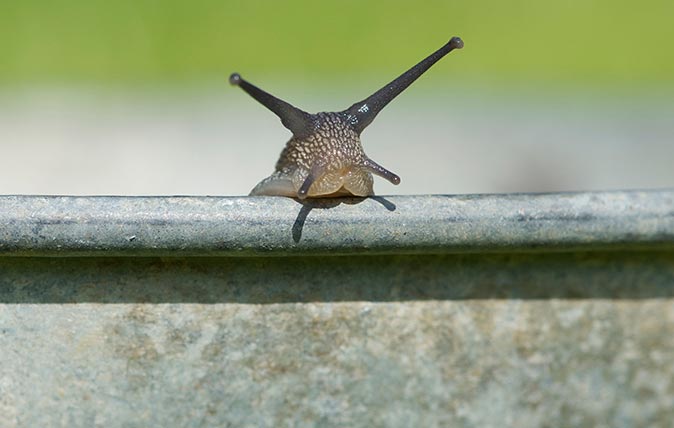Curious Questions: Does throwing a snail stop it from returning to your garden?
The oldest gardeners' remedy for getting rid of snails is also the simplest: throw them as far away as you can. But is it just an old wives' tale? Martin Fone, author of 'Fifty Curious Questions', investigates.


My wife and I are keen gardeners, she more so than I, although I am warming to the pastime in retirement. A perennial battle we wage is against the molluscs who take particular delight in munching their way through our carefully nurtured plants.
I was fascinated to read earlier this year that that august institution, the Royal Horticultural Society, is conducting experiments into the five most commonly cited popular slug remedies to ascertain which (if any) is the most efficacious. About blooming time, I say. I will be intrigued to discover the results.
I don’t have any truck with slugs but snails are an altogether different matter. I put it down to my childhood addiction to Eric Thompson’s wonderfully subversive Magic Roundabout. Dependable, plodding Brian the Snail was always my favourite character and perhaps over the years I have been guilty of associating his character traits with the molluscs that I encounter in my garden. The upshot is that whilst I have no qualms in despatching slugs I try to adopt more humane methods to encourage any snails I encounter to up sticks and move to pastures new.
https://youtu.be/_aBMn1NfXdc?t=26s
As a consequence I have eschewed the usual methods adopted by gardeners – setting beer traps (what a waste of beer!), collecting them and keeping them in a jar until they die or using some of the (expensive) pellets and chemical concoctions your friendly garden centre is only too willing to sell you.
No, the method of choice I adopt is to throw the mollusc as far as I can. My rationale is that as they are not known for their speed of travel, the problem will be transferred elsewhere – usually to an unsuspecting neighbour’s garden.
I have developed quite a technique. I use one of those litter picking devices to grasp the snail and then reliving my cricketing days of many moons ago, I adopt a bowling action, releasing the pincers just as my arm is descending. It is amazing the distance I can achieve.
Sign up for the Country Life Newsletter
Exquisite houses, the beauty of Nature, and how to get the most from your life, straight to your inbox.
Astonishingly, this may be the right approach to adopt, if you believe some research conducted by scientists from Queen Mary, the University of London and the University of Exeter and published in the ever popular Physica Scripta. The caveat is that you have to throw them more than 20 metres from where you found them. This seems to be far enough to discombobulate them.

Following a series of tests conducted since 2001 – nothing connected with snails moves along very quickly, it seems – and using techniques as sophisticated as marking their shells with correcting fluid, the scientists found that snails do have a homing instinct.
However – and this is the crucial point – once they are removed at least 20 metres from their home patch they are all at sea and will struggle to find their way back. For those concerned about gastropod cruelty, it seems that provided they are thrown into the undergrowth rather than a hard surface, they survive their impromptu and somewhat unexpected flight unscathed.
Regrettably, though, this is not the answer to complete elimination of the pests. Researchers have found that many more snails visit your garden regularly or irregularly than are present at any one time. So it is little more than one of those tasks that would occupy Sisyphus until eternity. The other problem, of course, is that you run the risk of tit-for-tat action from your less than understanding neighbours.
I have this wonderful image of a sunny Sunday afternoon in a leafy suburban neighbourhood. The picture is punctuated by the sight of the occasional mollusc being thrown back and forth over garden wall. Could become a spectator sport!
Martin Fone is author of 'Fifty Curious Questions', from which this piece is an excerpt – find out more about his book or you can order a copy via Amazon.
After graduating in Classics from Trinity College Cambridge and a 38 year career in the financial services sector in the City of London, Martin Fone started blogging and writing on a freelance basis as he slipped into retirement. He has developed a fearless passion for investigating the quirks and oddities of life and discovering the answers to questions most of us never even think to ask. A voracious reader, a keen but distinctly amateur gardener, and a gin enthusiast, Martin lives with his wife in Surrey. He has written five books, the latest of which is More Curious Questions.
-
 'There is nothing like it on this side of Arcadia': Hampshire's Grange Festival is making radical changes ahead of the 2025 country-house opera season
'There is nothing like it on this side of Arcadia': Hampshire's Grange Festival is making radical changes ahead of the 2025 country-house opera seasonBy Annunciata Elwes
-
 Jungle temples, pet snakes and the most expensive car in the world: Country Life Quiz of the Day, April 14, 2025
Jungle temples, pet snakes and the most expensive car in the world: Country Life Quiz of the Day, April 14, 2025Mondays's quiz tests your knowledge on English kings, astronomy and fashion.
By James Fisher
-
 The man who trekked Bhutan, Mongolia, Japan, Tasmania and New Zealand to bring the world's greatest magnolias back to Kent
The man who trekked Bhutan, Mongolia, Japan, Tasmania and New Zealand to bring the world's greatest magnolias back to KentMagnolias don't get any more magnificent than the examples in the garden at White House Farm in Kent, home of Maurice Foster. Many of them were collected as seed in the wild — and they are only one aspect of his enthralling garden.
By Charles Quest-Ritson
-
 The 'breathtakingly magnificent' English country gardens laid out on the Amalfi Coast, and the story of how they got there
The 'breathtakingly magnificent' English country gardens laid out on the Amalfi Coast, and the story of how they got thereKirsty Fergusson follows the Grand Tour to Campania in Italy, where the English combined their knowledge and love of plants with the rugged landscape to create gardens of extraordinary beauty.
By Kirsty Fergusson
-
 Have your say in the Historic Houses Garden of the Year Awards 2025
Have your say in the Historic Houses Garden of the Year Awards 2025By Annunciata Elwes
-
 Evenley Wood Garden: 'I didn't know a daffodil from a daisy! But being middle-aged, ignorant and obstinate, I persisted'
Evenley Wood Garden: 'I didn't know a daffodil from a daisy! But being middle-aged, ignorant and obstinate, I persisted'When Nicola Taylor took on her plantsman father’s flower-filled woodland, she knew more about horses than trees, but, as Tiffany Daneff discovers, that hasn’t stopped her from making a great success of the garden. Photographs by Clive Nichols.
By Tiffany Daneff
-
 An expert guide to growing plants from seed
An expert guide to growing plants from seedAll you need to grow your own plants from seed is a pot, some compost, water and a sheltered place.
By John Hoyland
-
 The best rhododendron and azalea gardens in Britain
The best rhododendron and azalea gardens in BritainIt's the time of year when rhododendrons, azaleas, magnolias and many more spring favourites are starting to light up the gardens of the nation. Here are the best places to go to enjoy them at their finest.
By Amie Elizabeth White
-
 Great Comp: The blissful garden flooded with rhododendrons and azaleas that's just beyond the M25
Great Comp: The blissful garden flooded with rhododendrons and azaleas that's just beyond the M25Each spring, Great Comp Garden — just outside the M25, near Sevenoaks — erupts into bloom, with swathes of magnolias, azaleas and rhododendrons. Charles Quest-Ritson looks at what has become one of the finest gardens to visit in Kent.
By Charles Quest-Ritson
-
 'I'm the expert who wrote the RHS's guide to roses — here's why pruning them right now is almost certainly a terrible mistake'
'I'm the expert who wrote the RHS's guide to roses — here's why pruning them right now is almost certainly a terrible mistake'More roses die from over-pruning than any other cause so what’s the reasoning underpinning this horticultural habit? Charles Quest-Ritson, the garden expert who wrote the RHS Encyclopedia of Roses, takes a closer look.
By Charles Quest-Ritson